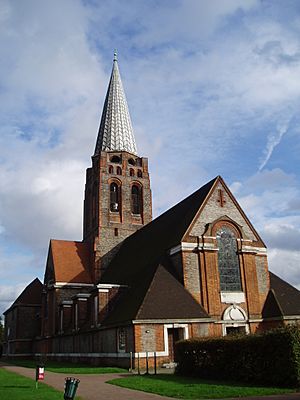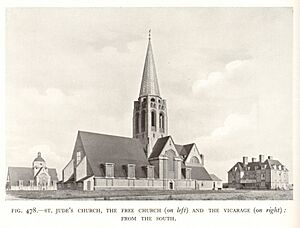St Jude's Church, Hampstead Garden Suburb facts for kids
Quick facts for kids St Jude's Church, Hampstead Garden Suburb |
|
|---|---|
| Parish Church of St Jude-on-the-Hill | |

Photo of St Jude's
|
|
| Location | London, NW117AH |
| Denomination | Church of England |
| Website | www.stjudeonthehill.com www.stjudeonthehill.org |
| History | |
| Dedicated | 1911 |
| Architecture | |
| Architect(s) | Edwin Lutyens |
| Years built | 1909 |
| Administration | |
| Parish | Hampstead Garden Suburb |
| Diocese | London (Edmonton Area) |
The Parish Church of St Jude-on-the-Hill, often called St Jude's, is a special church in Hampstead Garden Suburb in north London. This area was started in 1907 by Henrietta Barnett. She wanted to create a perfect community where people from all walks of life could live together in a beautiful and friendly place.
Contents
History of St Jude's Church
St Jude's Church was designed by a famous architect named Edwin Lutyens (1869–1944). He was known for his unique building styles.
The church is a mix of different styles. It uses a style called "Queen Anne Revival" but for a church building. Construction started in 1909. The main part of the church was finished and opened in 1911. However, the very front part (the west end) wasn't completed until 1935. From the outside, the church is about 61 meters (200 feet) long. Its tall spire reaches 54 meters (178 feet) into the sky.
Inside, the church is about 37 meters (122 feet) from the front door to the steps leading to the altar. The highest part of the roof is 12 meters (40 feet) high. The ceiling looks like a barrel and has domes. There are several domed sections, including a large one over the middle part of the church. The back part of the church, called the apse, was finished in 1923.
Art and Murals in the Church
The beautiful paintings and murals inside St Jude's were created by Walter P. Starmer (1877–1961). He started painting in the Lady Chapel in 1920 and finished the apse in 1929. Starmer helped during the First World War with the Red Cross. Many of his paintings from the war are now in the Imperial War Museum.
The large window at the west end of the church was dedicated in 1937. It was also designed by Starmer. It shows Saint Jude holding a cross and a small picture of this very church. Below him is a ship, which is his symbol. Above, you can see Christ in glory, surrounded by symbols of the four writers of the Gospels.
Near the west door, there is a special plaque that remembers the horses that died in the First World War. A sculpture of a warhorse by Rosemary Proctor (who died in 1995) is also there. This sculpture replaced earlier ones that were stolen. You can also find memorials to Basil Bourchier, who was the first vicar (church leader), and a plaque celebrating the completion of the west end. In the porch, there are pictures of past vicars.
The ceiling panels above the main aisle show different Bible stories. These include the wise men and shepherds, Jesus feeding many people, Jesus calming a storm, and Jesus healing the sick. The dome shows the crucifixion, and the chancel shows Jesus entering Jerusalem and carrying the cross.
On the north wall, there are memorials to John Raphael, a popular athlete who died in the First World War. There is also a statue of Father Maxwell Rennie, made by his daughter Rosemary Proctor. Above St George's altar, a painting by Starmer tells the story of Michael Rennie, the vicar's son. He died after saving children from a ship that was attacked during World War II.
The paintings in this area and the south aisle show Jesus's teachings through parables. The Stations of the Cross, which are a series of pictures showing Jesus's journey to the cross, also by Starmer, start here and continue into the south aisle.
Special Features and Chapels
The beautiful iron screens next to the altar are much older than the church itself. They were made by Matthias Heit in 1710. The floor around the altar is made of bricks and marble in a pattern. The main altar has two special stones from Canada. One is a dark stone from a very old French chapel in Nova Scotia, where the first European settlement in Canada was founded in 1605. The other is a lighter stone from the altar steps of Montreal Cathedral. The foundation stone of the church, on the north side of the chancel, was laid in 1910 and was made by Eric Gill. The pulpit, where sermons are given, was also a gift from Canada.
Above the south door, there is a plaque remembering when the Prince of Wales (who later became King Edward VIII) unveiled the murals in 1924. Above the door, there is a figure of Christ by Rosemary Proctor, in memory of her brother. Nearby, on the south wall, is a memorial to King Edward VII.
To the left of the main altar is the Lady Chapel. This is the oldest part of the church, finished in 1910. On a pillar at the entrance, there is a guide to the ceiling painting. This painting shows brave women connected to the First World War and the fight for women's rights. Above the arch, there is a memorial about the unveiling of the frescoes (wall paintings). In the chapel's altar area, there is a wooden statue of Our Lady, which is a copy of a 16th-century statue. Its unusual shape suggests it was meant to be placed very high up and seen from far below. The central part of the altar has a modern copy of the Madonna and Child by Bernini.
St John's Chapel, to the right of the main altar, was a gift from the Harmsworth family in 1923. The murals here are inspired by the Gospel of John and the Book of Revelation. The memorial window for Robert Lovel St John Harmsworth (1898–1920) was made by Robert Anning Bell, a very talented artist. It is considered one of his most charming designs.
The green and white marble altar in St John's Chapel was designed by Lutyens. In the middle of the altar, there is a picture by Maurice Greiffenhagen of St John holding a cup with a snake coming out of it. This refers to an old story where St John was given poison to drink as a test, but he survived and even brought others back to life. The church offices (vestries) are located behind the altar of St John.
St Jude's Church is usually open during service times and sometimes on summer Sunday afternoons. Because it is often used for recordings, concerts, and other events, it's a good idea to check their website if you plan to visit. Groups are welcome, and with enough notice, a guide can often be arranged.
As of 2022, St Jude's is on Historic England's 'Heritage at Risk' list, meaning it needs care to preserve it. The house next to the church, where the vicar lives, was also designed by Lutyens and is a protected building.
St Jude's in Books and Writings
Many famous writers have mentioned St Jude's Church:
- Evelyn Waugh, a well-known author, was confirmed at St Jude's in 1916. He wrote about the church and its lively vicar, Basil Bourchier, saying that despite the vicar's dramatic style, he "had some glimpse of higher mysteries."
- C.S. Lewis, who wrote The Chronicles of Narnia, gave two sermons at St Jude's. He spoke about "Miracles" in 1942 and "The Grand Miracle" in 1945.
People have described St Jude's in many ways:
- Roslin Mair called it "a building of true originality" and a "key work" of its time.
- Simon Jenkins said it was Lutyens' "church masterpiece" and "one of the best twentieth-century church exteriors in England."
- Bridget Cherry and Nikolaus Pevsner noted that it shows Lutyens' best qualities and that its unique style is a "decided advantage."
- Peter Anson described it as a "magnificent Edwardian period piece" with "wonderful gay furnishings" and "gorgeous" decorations.
- John Leonard highlighted that it was very modern for its time, completely avoiding the older Gothic style. He called the central tower "majestic, imperious" and the interior "impressive."
St Jude's in Music
Charles Proctor was the organist and choirmaster at St Jude's from 1943 to 1973. He married Rosemary Rennie, the daughter of a former vicar, and some of her artwork can be seen in the church.
The church has a special organ, known as a "Father Willis" organ. It originally came from another St Jude's church in Whitechapel. It was moved to its current spot in the chancel in 1934 after being restored. The organ was fully rebuilt and renovated in 2002.
Because the church has excellent acoustics (meaning sound travels very well), it is often used as a place to record music.
- In 1980, Evan Parker recorded his solo saxophone album Six of One here.
- In 1981, the album A Feather on the Breath of God, featuring music by Hildegard of Bingen, was recorded by Gothic Voices with Emma Kirkby.
- In 1988, Arvo Pärt's Passio was recorded by the Hilliard Ensemble.
- Between 1989 and 1990, Bryden Thomson and the London Symphony Orchestra recorded several symphonies by Ralph Vaughan Williams at the church, including Sinfonia antartica.
Since 1992, the church has hosted an annual music festival called Proms at St Jude's. Nicholas Chalmers has been the organist and music director since 1993.



